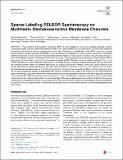Files in this item
Sparse labeling PELDOR spectroscopy on multimeric mechanosensitive membrane channels
Item metadata
| dc.contributor.author | Ackermann, Katrin | |
| dc.contributor.author | Pliotas, Christos | |
| dc.contributor.author | Valera, Silvia | |
| dc.contributor.author | Naismith, Jim | |
| dc.contributor.author | Bode, Bela Ernest | |
| dc.date.accessioned | 2017-11-09T15:30:09Z | |
| dc.date.available | 2017-11-09T15:30:09Z | |
| dc.date.issued | 2017-11-07 | |
| dc.identifier | 251009499 | |
| dc.identifier | 1495c42d-c837-4619-9003-41e9b6c4731f | |
| dc.identifier | 85032971463 | |
| dc.identifier | 000416212300010 | |
| dc.identifier.citation | Ackermann , K , Pliotas , C , Valera , S , Naismith , J & Bode , B E 2017 , ' Sparse labeling PELDOR spectroscopy on multimeric mechanosensitive membrane channels ' , Biophysical Journal , vol. 113 , no. 9 , pp. 1968–1978 . https://doi.org/10.1016/j.bpj.2017.09.005 | en |
| dc.identifier.issn | 0006-3495 | |
| dc.identifier.other | ORCID: /0000-0002-4309-4858/work/38548531 | |
| dc.identifier.other | ORCID: /0000-0002-3384-271X/work/38548532 | |
| dc.identifier.uri | https://hdl.handle.net/10023/12038 | |
| dc.description | BEB is grateful for funding from the European Union (Marie Curie Actions REA 334496). This work was supported by the EPSRC (EP/M024660/1) and the Wellcome Trust (099149/Z/12/Z). CP is a Royal Society of Edinburgh (RSE) Personal Research Fellow, funded by the Scottish Government. | en |
| dc.description.abstract | Pulse EPR is being applied to ever more complex biological systems comprising multiple subunits. Membrane channel proteins are of great interest as pulse EPR reports on functionally significant but distinct conformational states in a native environment without the need for crystallization. Pulse EPR, in the form of pulsed electron-electron double resonance (PELDOR), using site-directed spin labeling is most commonly employed to accurately determine distances (in the nanometer range) between different regions of the structure. However, PELDOR data analysis is more challenging in systems containing more than two spins (e.g. homo-multimers) due to distorting multi-spin effects. Without suppression of these effects much of the information contained in PELDOR data cannot be reliably retrieved. Thus, it is of utmost importance for future PELDOR applications in structural biology to develop suitable approaches that can overcome the multi-spin problem.Here, two different appro aches for suppressing multi-spin effects in PELDOR, sparse labeling of the protein (reducing the labeling efficiency f) and reducing the excitation probability of spins (λ), are compared on two distinct bacterial mechanosensitive channels. For both, the pentameric channel of large conductance (MscL) and the heptameric channel of small conductance (MscS) of E. coli, mutants containing a spin label in the cytosolic or the transmembrane region were tested. Data demonstrate that distance distributions can be significantly improved with either approach compared to the standard PELDOR measurement, and confirm that λ < 1/(n−1) is needed to sufficiently suppress multi-spin effects (with n being the number of spins in the system). A clear advantage of the sparse labeling approach is demonstrated for the cytosolic mutants due to a significantly smaller loss in sensitivity. For the transmembrane mutants, this advantage is less pronounced but still useful for MscS, but performance is inferior for MscL possibly due to structural perturbations by the bulkier diamagnetic spin label analogue. | |
| dc.format.extent | 3056297 | |
| dc.language.iso | eng | |
| dc.relation.ispartof | Biophysical Journal | en |
| dc.subject | QD Chemistry | en |
| dc.subject | QH301 Biology | en |
| dc.subject | DAS | en |
| dc.subject | BDC | en |
| dc.subject.lcc | QD | en |
| dc.subject.lcc | QH301 | en |
| dc.title | Sparse labeling PELDOR spectroscopy on multimeric mechanosensitive membrane channels | en |
| dc.type | Journal article | en |
| dc.contributor.sponsor | EPSRC | en |
| dc.contributor.sponsor | European Commission | en |
| dc.contributor.sponsor | The Wellcome Trust | en |
| dc.contributor.sponsor | The Royal Society of Edinburgh | en |
| dc.contributor.institution | University of St Andrews. School of Chemistry | en |
| dc.contributor.institution | University of St Andrews. School of Biology | en |
| dc.contributor.institution | University of St Andrews. EaSTCHEM | en |
| dc.contributor.institution | University of St Andrews. Biomedical Sciences Research Complex | en |
| dc.contributor.institution | University of St Andrews. Centre of Magnetic Resonance | en |
| dc.identifier.doi | 10.1016/j.bpj.2017.09.005 | |
| dc.description.status | Peer reviewed | en |
| dc.identifier.grantnumber | EP/M024660/1 | en |
| dc.identifier.grantnumber | en | |
| dc.identifier.grantnumber | 099149/Z/12/Z | en |
| dc.identifier.grantnumber | en |
This item appears in the following Collection(s)
Items in the St Andrews Research Repository are protected by copyright, with all rights reserved, unless otherwise indicated.

